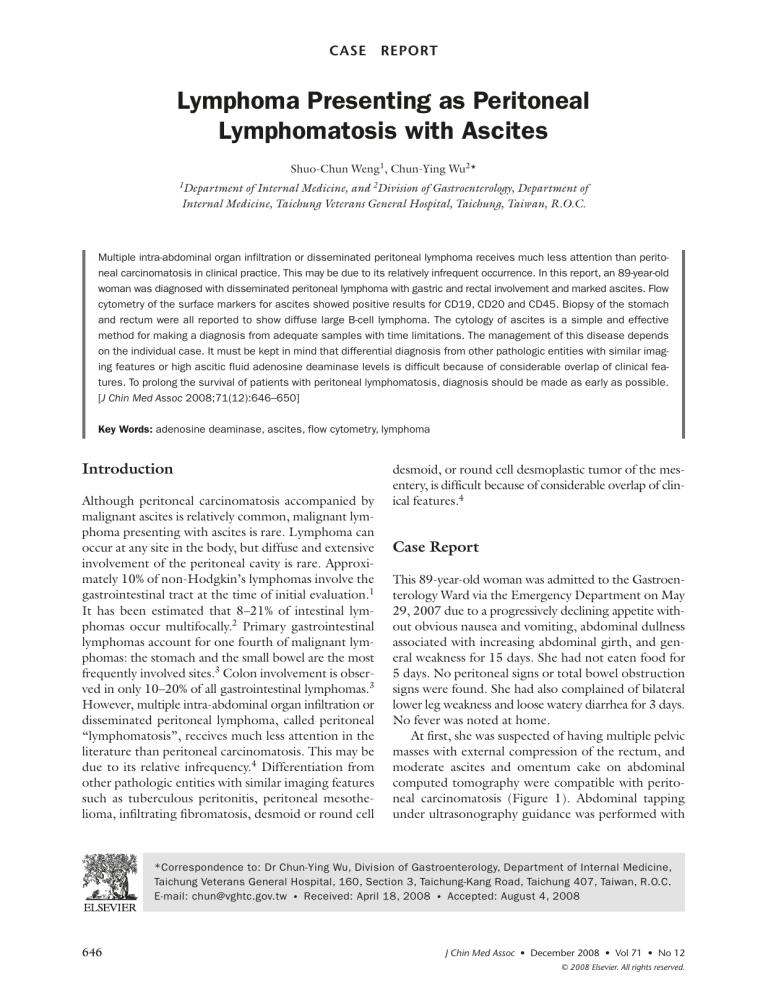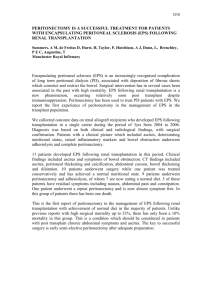Lymphoma Presenting as Peritoneal Lymphomatosis with Ascites

CASE REPORT
Lymphoma Presenting as Peritoneal
Lymphomatosis with Ascites
Shuo-Chun Weng 1 , Chun-Ying Wu 2 *
1 Department of Internal Medicine, and 2 Division of Gastroenterology, Department of
Internal Medicine, Taichung Veterans General Hospital, Taichung, Taiwan, R.O.C.
Multiple intra-abdominal organ infiltration or disseminated peritoneal lymphoma receives much less attention than peritoneal carcinomatosis in clinical practice. This may be due to its relatively infrequent occurrence. In this report, an 89-year-old woman was diagnosed with disseminated peritoneal lymphoma with gastric and rectal involvement and marked ascites. Flow cytometry of the surface markers for ascites showed positive results for CD19, CD20 and CD45. Biopsy of the stomach and rectum were all reported to show diffuse large B-cell lymphoma. The cytology of ascites is a simple and effective method for making a diagnosis from adequate samples with time limitations. The management of this disease depends on the individual case. It must be kept in mind that differential diagnosis from other pathologic entities with similar imaging features or high ascitic fluid adenosine deaminase levels is difficult because of considerable overlap of clinical features. To prolong the survival of patients with peritoneal lymphomatosis, diagnosis should be made as early as possible.
[ J Chin Med Assoc 2008;71(12):646–650]
Key Words: adenosine deaminase, ascites, flow cytometry, lymphoma
Introduction
Although peritoneal carcinomatosis accompanied by malignant ascites is relatively common, malignant lymphoma presenting with ascites is rare. Lymphoma can occur at any site in the body, but diffuse and extensive involvement of the peritoneal cavity is rare. Approximately 10% of non-Hodgkin’s lymphomas involve the gastrointestinal tract at the time of initial evaluation.
1
It has been estimated that 8–21% of intestinal lymphomas occur multifocally.
2 Primary gastrointestinal lymphomas account for one fourth of malignant lymphomas: the stomach and the small bowel are the most frequently involved sites.
3
Colon involvement is observed in only 10–20% of all gastrointestinal lymphomas.
3
However, multiple intra-abdominal organ infiltration or disseminated peritoneal lymphoma, called peritoneal
“lymphomatosis”, receives much less attention in the literature than peritoneal carcinomatosis. This may be due to its relative infrequency.
4 Differentiation from other pathologic entities with similar imaging features such as tuberculous peritonitis, peritoneal mesothelioma, infiltrating fibromatosis, desmoid or round cell desmoid, or round cell desmoplastic tumor of the mesentery, is difficult because of considerable overlap of clinical features.
4
Case Report
This 89-year-old woman was admitted to the Gastroenterology Ward via the Emergency Department on May
29, 2007 due to a progressively declining appetite without obvious nausea and vomiting, abdominal dullness associated with increasing abdominal girth, and general weakness for 15 days. She had not eaten food for
5 days. No peritoneal signs or total bowel obstruction signs were found. She had also complained of bilateral lower leg weakness and loose watery diarrhea for 3 days.
No fever was noted at home.
At first, she was suspected of having multiple pelvic masses with external compression of the rectum, and moderate ascites and omentum cake on abdominal computed tomography were compatible with peritoneal carcinomatosis (Figure 1). Abdominal tapping under ultrasonography guidance was performed with
*Correspondence to: Dr Chun-Ying Wu, Division of Gastroenterology, Department of Internal Medicine,
Taichung Veterans General Hospital, 160, Section 3, Taichung-Kang Road, Taichung 407, Taiwan, R.O.C.
E-mail: chun@vghtc.gov.tw
●
Received: April 18, 2008
●
Accepted: August 4, 2008
646
J Chin Med Assoc • December 2008 • Vol 71 • No 12
© 2008 Elsevier. All rights reserved.
Peritoneal lymphomatosis with ascites
Figure 1.
Abdominal computed tomography shows: (A) multiple huge pelvic masses with external compression of the rectum, and moderate ascites (arrows); and (B) omentum cake (arrow), which were compatible with peritoneal carcinomatosis.
Figure 2.
Cytology of ascites shows malignant lymphoid cells with large hyperchromatic nuclei and high nuclear/cytoplasmic ratio
(1,000
×
). Flow cytometry of surface markers showed positivity for
CD19, CD20 and CD45.
the following results: ascites white blood cell count of
43,560/mm 3 , adenosine deaminase (ADA) level of
695 U/L, lactate dehydrogenase level of 2,001 U/L, protein of 2,500 mg/dL, and albumin of 1.4 g/dL
(serum albumin, 2.5 g/dL). Abdominal tuberculosis was considered to be the source of illness due to high ascites ADA level mimicking peritoneal tuberculosis.
Surprisingly, cytology of the ascites showed malignant lymphoma and lymphoid cells with large hyperchromatic nuclei and high nuclear/cytoplasmic ratio
(Figure 2). The thickened rectal wall was examined by a physician, and the thickened rectal wall with peritoneal lymphomatosis was suspected to be malignant after colonofiberscopy revealed external compression at the rectum. However, 1 huge gastric ulcer was found, and was also suspected to be malignant after panendoscopy (Figure 3A).
Biopsy tissues of both studies showed diffuse large
B-cell lymphomas. A section of the gastric tissue over the high body of the stomach showed atypical lymphoid cell proliferation, with enlarged hyperchromatic nuclei, irregular membrane and occasionally prominent nucleoli without findings of Helicobacter -like microorganism (Giemsa stain) and immunohistochemistry stains for L26( + ) and OPD4( − ). We found the tumor cells to be immunoreactive for L26 (CD20) antigen
(Figure 3B). Endoscopic ultrasonography (EUS; performed with an Olympus UM2000 conventional echoprobe) of the lower gastrointestinal tract showed mostly intact rectal wall (Figure 4). However, marked perirectal mass infiltration and distal rectal invasion were noted, and the thickness was greater than 5 cm.
The distal rectum was probably invaded by the tumor as the wall layers could not be well identified. Marked pericolonic ascites was also noted with the appearance of carcinomatosis.
The cytology of ascites under flow cytometry of the surface marker showed positive results for CD19,
CD20 and CD45, while a bone marrow biopsy was also performed but revealed no lymphoma invasion. After providing a detailed explanation of the treatment for diffuse peritoneal lymphoma to the patient and her family, her family refused any treatment due to the patient’s old age. Her condition deteriorated with progressively poor appetite and refractory ascites despite symptomatic treatment. She died soon after, within 4 months of being diagnosed with peritoneal lymphomatosis.
Discussion
Lymphoma presenting as peritoneal carcinomatosis is rare, and there is no definite demographic characteristics
J Chin Med Assoc • December 2008 • Vol 71 • No 12
647
S.C. Weng, C.Y. Wu
B A
Figure 3.
(A) Panendoscopy: 1 huge gastric ulcer (asterisk) over the high body of the stomach was suspected to be malignancy.
(B) Tumor cells were immunoreactive for L26 (CD20) antigen (200
×
).
Figure 4.
Endoscopic ultrasonography of the lower gastrointestinal tract shows the mostly intact rectal wall. Marked perirectal mass infiltration with distal rectal invasion were noted, while thickness was more than 5 cm. The distal rectum was probably invaded by the tumor as the wall layers could not be well identified. Marked pericolonic ascites was noted with the appearance of carcinomatosis.
after comparison of each country’s data. Runyon and
Hoefs described 1 series of 101 cytology-positive cases of malignant ascites in which only 8 cases (8%) of lymphoma were reported.
4 Variation in age distribution but predominance in elderly people was found. Most primary lymphomas complicated with ascites or peritoneal lymphomatosis and carcinomatosis are located in the abdomen and present as extranodal involvement.
Our case showed a diffuse large B-cell lymphoma
(DLBCL), which is the most common histologic type of non-Hodgkin’s lymphoma in adults.
5
Forty percent of these cases may present as extranodal tumors.
6
It seems that B-cell lymphomas account for a large part of the pathologic findings, and most gastrointestinal lymphomas are localized and express B-cell phenotypes.
2
Gastrointestinal DLBCL is the most frequent extranodal lymphoma, with the most common location being below the diaphragm, followed by the small intestine and colon–rectum.
7
Imaging for ascites and preoperative evaluation of patients with peritoneal carcinomatosis is mostly via abdominal computed tomography, but abdominal tapping is always performed under ultrasound guidance.
Advances in imaging techniques including magnetic resonance imaging (MRI) and EUS have greatly aided evaluation of tumor extension and invasion. EUSguided fine needle aspiration biopsy (EUS-FNA) is a recent innovation in the evaluation of gastrointestinal and pulmonary malignancies. It is a safe and accurate device for obtaining tissue specimens that are suitable for cytopathologic diagnoses. The overall accuracy of
EUS-FNA for the diagnosis of malignancy in a large case series was 86%, with a sensitivity of 84% and specificity of 96%.
8 Williams et al reported individualized aspects of different lesion types in which the sensitivity, specificity, and accuracy were, respectively, 85%,
100%, and 89% for lymph nodes, 82%, 100%, and 85% for pancreatic lesions, 88%, 100%, and 90% for perirectal masses, and 50%, 25%, and 38% for intramural lesions.
8 EUS-FNA in the evaluation of lymph nodes is known to provide superior accuracy and specificity without compromising sensitivity.
8 Our transrectal approach showed distinguishable echogenicity about mostly intact rectal walls, marked perirectal mass infiltration with distal rectal invasion, glimmering tumor capsule, and the surrounding background. FNA was also performed using a real-time procedure.
In our patient, the ADA level in ascites was extremely high, and we first misdiagnosed it as tuberculous
648
J Chin Med Assoc • December 2008 • Vol 71 • No 12
Peritoneal lymphomatosis with ascites peritonitis. It should be kept in mind that non-
Hodgkin’s lymphoma has high ascitic fluid ADA levels that are similar to nonresponders to antituberculosis treatment.
9 ADA essentially participates in the purine salvage pathway of DNA metabolism and is found in erythrocytes, lymphocytes and the cerebral cortex.
9
ADA activity increases during the antigenic response of lymphocytes; however, ADA levels in ascites have rarely been reported in the diagnosis of lymphoma.
9
In the light of these findings, ADA level may not reflect tuberculous peritonitis in the absence of histopathologic examination. Determining ascitic fluid ADA activity is most useful in areas where tuberculosis is endemic.
9 However, tuberculous peritonitis should really be taken into consideration, especially in Taiwan where there is a high prevalence of tuberculosis. ADA levels had a diagnostic sensitivity of 94.2% and a positive predictive value of 75% in discriminating tuberculosis from other causes of ascites.
10,11
High levels of
ADA have also been reported in noninfectious conditions associated with peritoneal and pleural fluid lymphocytosis, including malignant conditions (e.g.
adenocarcinomas, leukemias, lymphomas) and collagen vascular diseases (e.g. rheumatoid pleuritis, systemic lupus erythematosus).
12 Therefore, an increasing
ADA level should not be considered as an equivalent to the presence of mycobacteria.
12
Wang et al reported a high resistance index of Doppler ultrasound in tuberculous peritonitis presenting as abdominal carcinomatosis.
13 This patient also had the identical presentation of elevated protein level in ascites, lactate dehydrogenase, low glucose concentration, and sterile ascites, all of which are compatible with the clinical features of peritoneal lymphomatosis.
4
One limitation when diagnosing lymphomas in effusions or ascites is the inability to analyze lymph node architecture. With the help of ancillary studies, such as flow cytometry and immunohistochemical staining, an accurate diagnosis can now be made in the majority of cases. Cytologic diagnosis is often limited to phenotypes of lymphoma, and usually requires morphologic presentation for non-Hodgkin’s lymphoma.
The final pathology report may include clinical features, morphology, and the immunophenotype, karyotype and molecular characteristics. However, the objectives of molecular diagnosis of lymphoma are the detection of clonality, translocations or genetic abnormalities, which can be achieved by means of Southern blotting, polymerase chain reaction, flow cytometry and immunocytochemistry.
14 In effusions or ascites,
T-cell lymphomas are much less common than B-cell lymphomas. It is also much more difficult to demonstrate clonality in T-cell lymphomas than in B-cell lymphomas, in which monoclonality is readily demonstrated by monotypic staining for immunoglobulin.
15
Elevated serum CA125 has been shown to be a quick and safe diagnostic tool in the differentiation between ovarian carcinoma and lymphoma, and is used in place of laparotomy in the majority of cases.
16
However, several unusual cases with inconclusive imaging, clinical and laboratory features have led initially to a false presumptive diagnosis and required explorative laparotomy.
16 When treating lymphoma, one should consider the utility of image-guided aspiration or biopsy in order to avoid laparotomy or even erroneous tumor debulking.
In conclusion, this case illustrates simple cytology and presents an effective method for making a diagnosis with an adequate sample. The best choice for diagnosis and staging of a primary site is EUS-FNA, approaching the upper and lower gastrointestinal tract after abdominal computed tomography. Disseminated peritoneal involvement of extranodal and gastrointestinal lymphoma is very unusual and needs further attention.
Acknowledgments
The authors are grateful to Dr Ming-Cheng Zhang,
Department of Pathology, Taichung Veterans
General Hospital, Taichung, Taiwan, and Mr Ian
Paterson for reading the article and offering helpful suggestions.
References
1. Kim YS, Cho OK, Song SY, Lee HS, Rhim HC, Koh BH.
Peritoneal lymphomatosis: CT findings. Abdom Imaging
1998;23:87–90.
2. Tsutsumi Y, Inada KI, Morita K, Suzuki T. T-cell lymphomas diffusely involving the intestine: report of two rare cases. Jpn J
Clin Oncol 1996;26:264–72.
3. Cho IJ, Park MY, Jang SN, Kwon BJ, Nam HS, Park KW,
Jang EC, et al. A case of primary colonic lymphoma with peritoneal carcinomatosis and pleural effusion.
Korean J Gastrointest
Endosc 2006;33:244–7.
4. Runyon BA, Hoefs JC. Peritoneal lymphomatosis with ascites.
Arch Intern Med 1986;146:887–8.
5. Ohshima K, Suzumiya J, Sato K, Kanda M, Haraoka S, Kikuchi M.
B-cell lymphoma of 708 cases in Japan: incidence rates and clinical prognosis according to the REAL classification. Cancer
Lett 1999;135:73–81.
6. Armitage JO, Mauch PM, Harris NL, Bierman P. Lymphomas: non-Hodgkin’s lymphomas. In: De Vita VT Jr, ed. Cancer:
Principles and Practice of Oncology.
Philadelphia: Lippincott,
2001:2256–316.
7. d’Amore F, Christensen BE, Brincker H, Pedersen NT,
Thorling K, Hastrup J, Pedersen M, et al. Clinicopathological
J Chin Med Assoc • December 2008 • Vol 71 • No 12
649
S.C. Weng, C.Y. Wu features and prognostic factors in extranodal non-Hodgkin’s lymphomas. Eur J Cancer 1991;27:1201–8.
8. Williams DB, Sahai AV, Aabakken L, Penman ID, Velse A, Webb J,
Wilson M, et al. Endoscopic ultrasound-guided fine needle aspiration biopsy: a large single-centre experience. Gut 1999;44:720–6.
9. Buyukberber M, Sevinc A, Cagliyan CE, Gulsen MT, Sari I,
Camci C. Non-Hodgkin’s lymphoma with high adenosine deaminase levels mimicking peritoneal tuberculosis: an unusual presentation. Leuk Lymphoma 2006;47:565–8.
10. Hwangbo Y, Jung JH, Shim J, Kim BH, Jung SH, Lee CK,
Jang JY, et al. Etiologic and laboratory analyses of ascites in patients who underwent diagnostic paracentesis. Korean J Hepatol
2007;13:185–95.
11. Voigt MD, Kalvaria I, Trey C, Berman P, Lombard C, Kirsch RE.
Diagnostic value of ascites adenosine deaminase in tuberculous peritonitis.
Lancet 1989;8641:751–4.
12. Laniado-Laborín R. Adenosine deaminase in the diagnosis of tuberculous pleural effusion: is it really an ideal test? A word of caution . Chest 2005;127:417–8.
13. Wang PH, Yuan CC, Yu KJ, Lee RC, Linn JJ, Hung JH,
Chao HT. High resistance index of Doppler ultrasound in tuberculous peritonitis presenting as abdominal carcinomatosis: report of two cases. J Chin Med Assoc 1998;61:175–9.
14. Kocjan G. Cytological and molecular diagnosis of lymphoma.
J Clin Pathol 2005;58:561–7.
15. Vakar-Lopez F, Yang M. Peripheral T-cell lymphoma presenting as ascites: a case report and review of the literature.
Diagn
Cytopathol 1999;20:382–4.
16. Horger M, Müller-Schimpfle M, Yirkin I, Wehrmann M,
Claussen CD. Extensive peritoneal and omental lymphomatosis with raised CA 125 mimicking carcinomatosis: CT and intraoperative findings. Br J Radiol 2004;77:71–3.
650
J Chin Med Assoc • December 2008 • Vol 71 • No 12





